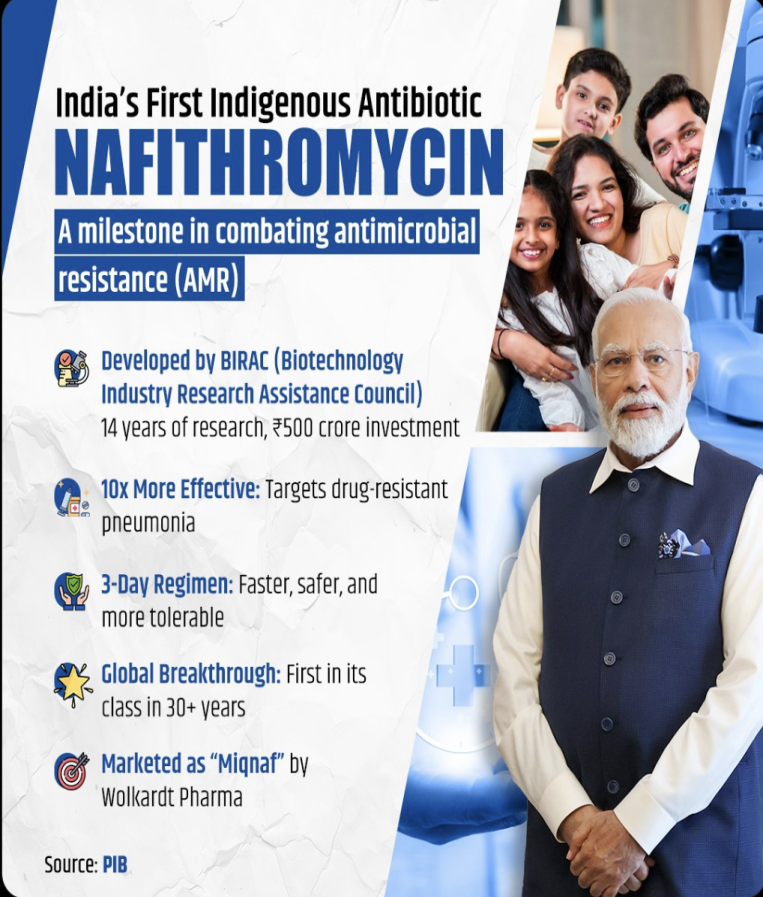Nafithromycin: India’s First Indigenous Antibiotic Launched
Why in the news?
Union Minister launched Nafithromycin, India’s first indigenously developed antibiotic, addressing Antimicrobial Resistance and Community-Acquired Bacterial Pneumonia with high efficacy and safety, supported by BIRAC.
Introduction of India’s First Indigenous Antibiotic:
- The Union Minister launched Nafithromycin, India’s first indigenously developed antibiotic, under the trade name “Miqnaf”.
- This breakthrough innovation marks a significant achievement for India’s biotechnology sector.
- Developed with support from the Biotechnology Industry Research Assistance Council (BIRAC), Nafithromycin addresses critical healthcare challenges.
Key Features and Benefits:
- Primarily designed to combat Antimicrobial Resistance (AMR) and treat Community-Acquired Bacterial Pneumonia (CABP).
- Demonstrates 10x efficacy compared to existing antibiotics, requiring only three doses for treatment.
- Effective against both typical and atypical bacterial pathogens.
- Offers a safe profile with minimal side effects, no drug interactions, and compatibility with food consumption.
About Nafithromycin: Key Highlights
- Developed with Biotechnology Industry Research Assistance Council (BIRAC) support.
- Marketed under the trade name “Miqnaf”, India’s first indigenously developed antibiotic.
- Targets Antimicrobial Resistance (AMR) and treats Community-Acquired Bacterial Pneumonia (CABP).
- Effective against typical and atypical pathogens; first in its class in over 30 years globally.
- Minimal side effects, no drug interactions, and food-compatibility.
- Delivers 10x efficacy with just three doses.
- Developed over 14 years with a ₹500 crore investment; trials held in India, the U.S., and Europe.
Key Facts about Community-Acquired Bacterial Pneumonia (CABP):
- A common infectious disease contributing significantly to global mortality and morbidity.
- Caused by typical bacterial pathogens like Streptococcus pneumoniae, Haemophilus influenzae, and Moraxella catarrhalis.
About Antimicrobial Resistance (AMR):
- Occurs when microorganisms like bacteria, viruses, fungi, and parasites adapt, making medicines ineffective.
- Leads to infections being harder to treat, raising risks of severe illness, disease spread, and mortality.
- Antibiotics and antimicrobials become ineffective, complicating treatment.
About Central Drugs Standard Control Organisation (CDSCO):
- India’s National Regulatory Authority (NRA) under the Ministry of Health & Family Welfare.
- Headquarters: New Delhi; headed by the Drugs Controller General of India (DCGI).
- Mandates under the Drugs and Cosmetics Act:
- Approving new drugs.
- Overseeing clinical trials.
- Setting drug standards.
- Ensuring quality of imported drugs.
- Coordinating State Drug Control Organizations.
Sources Referred:
PIB, The Hindu, Indian Express, Hindustan Times





